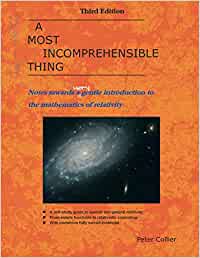 This is the best book on General Relativity (GR) that I have read. It took me four tries to get all the way through it. Each time it got a little easier. Normally, I would describe the contents of the book in notes form so that I could review the book again later. I cannot do that here for several reasons. There is a lot of math. You need special software to typeset math. You cannot begin to understand GR without it. But I cannot even write down his famous equation (it is actually quite short, only 9 characters long, with proper assumptions), or any of the mathematical statements because they are hip deep Greek letters, superscripts, subscripts, indexes, tensors and mathematical operators. For the record, I got through 2nd year university mathematics before switching to computer science. I thought myself quite good at math in high school (# 2 in the school, as I recall), but that is a far cry from the mathematics needed for GR. You must be familiar with basic calculus to get very far in this book. The mathematics of GR is called "differential geometry" and it is based on tensors. Tensors were difficult for Einstein, so I do not feel bad that I find them hard too. A tensor is a lot like a matrix. Matrices can be added and multiplied etc much like ordinary numbers. A matrix is a tensor if after any valid tensor operations or transformations, a certain calculated value derived from the tensor always remains unchanged. That value can be thought of as the "distance" between two points… also called "the metric". Part of what Einstein did is formulate several possible metrics that conform to his GR principle. Here is what GR says: Space tells matter how to go; Matter tells space how to bend. That is it really. We live in a flat Euclidian world. We can carve up our world using a simple coordinate system to locate things in time and space, and we use Pythagoras' famous equation for the metric. We need to add one more space term because we live in a three dimensional world, and another for time, but it works exactly the same as original 2D Pythagorean formula we all learned in high school. You will often see the time coordinate multiplied by "c", the speed of light, but that is just an artifact of a units choice. If you measure speed as a fraction of "c", the "c" disappears. GR is extremely difficult mathematically. Finding general solutions to Einstein's equation is damn near impossible. But if simplifying assumptions can be built into the metric, things get easier. The metric in GR is the goal in many ways. The most famous one is called the Schwarzschild Metric. It describes a non-spinning, chargeless, mass in empty space. It was used to derive some of the more interesting aspects of GR, such a gravitational red shift and gravitational bending of light. It is worth mentioning just how important one idea is to GR. This is Einstein's "happiest moment"… the realization that the Equivalence Principle must be true. Stated simply, it says there is no experiment that can be performed that can distinguish between a uniform gravity field, and uniform acceleration. One of the main reasons it took so long for the formulation of relativity is that we, walking about on the Earth, are accelerating. That is, we are not in an "inertial frame of reference", which is one that that moves at a constant velocity (i.e.: no acceleration). If we could observe everything from such a vantage, the basic laws of motion would have been blindingly obvious. From an inertial frame of reference, a hit baseball travels in a straight line forever. The fact that our frame of reference is accelerating turns it into a parabola and makes it hit the Earth. We live in a very nearly uniform gravity field. It is not uniform, even for an ideal Earth (perfectly spherical and of uniform density), because the forces of gravity diverge a tiny bit (resulting in tides). If you drop a ball, it falls to the ground at 32 ft/sec/sec. If you are way out in space in a space ship that is accelerating at 1 G exactly, and you drop a ball, the exact same thing will happen. And there is no way (in physics) to tell the difference. This simple realization is one of the core assumptions upon which GR us built. Mercury's perihelion (closest approach to the sun) precesses. That is, it moves very slowly, taking 225,000 years to get back to its original point. The fact that they could make these fine measurements around 1900 is astounding. Most of that precession can be explained by Newtonian calculations of the tugs of the other planets. But not all. A tiny bit was left over, and Einstein said that relativity could account for the it. This was verified. This is incredible accuracy. A second of arc is the width of a penny at 2.36 kilometers! What was at issue was 43 seconds of arc per century! And that is exactly what GR predicted. Eddington famously went to the island if Principe in 1919 and did measurements of star positions very close to the sun during a total solar eclipse. They were deflected by the mass of the sun (which Newton would not have predicted). Space around the sun was bent, as predicted by Einstein. I made a lot of written notes as I worked, and reworked, my way through this book. I will use them when I tackle it one more time in 5 years or so. One does not have to be able to follow all of the math in this book. God knows I did not. But it is possible to see the math from a slightly higher perspective and understand that "this bit of the formula accounts for this, and that bit for that", etc. Fun fact: We all know Einstein's most famous equation E=MC2 that "popped out" of Special Relativity, Namely energy equals mass times the speed of light squared (a very large number). Apparently, the derivation of this famous equation involved many pages of calculations (i.e., equation manipulation). And just when it all seemed like it was going nowhere, all the various terms canceled each other out, leaving the one equation we all recognize. I really enjoy digging into this type of "origin, workings, and fate of the universe" physics. It is like looking the god of Spinoza right I the eye, and as close to the Rapture as I will ever get. .
0 Comments
|
AuthorLee Moller is a life-long skeptic and atheist and the author of The God Con. Archives
May 2024
Categories
All
|

 RSS Feed
RSS Feed